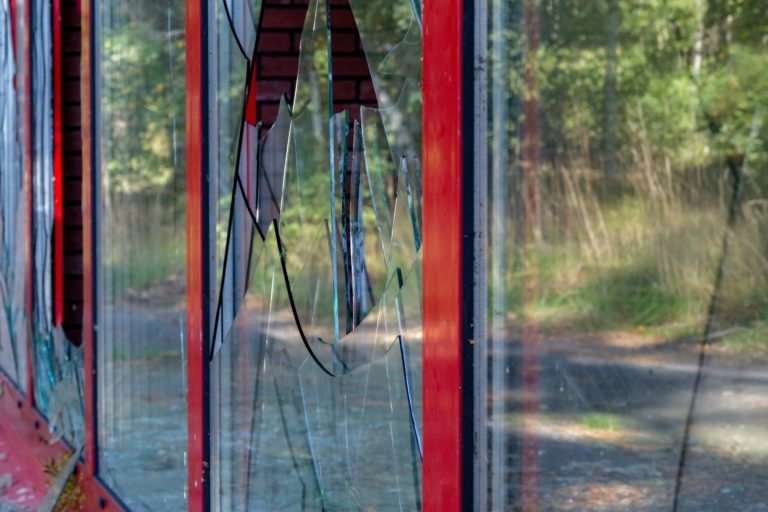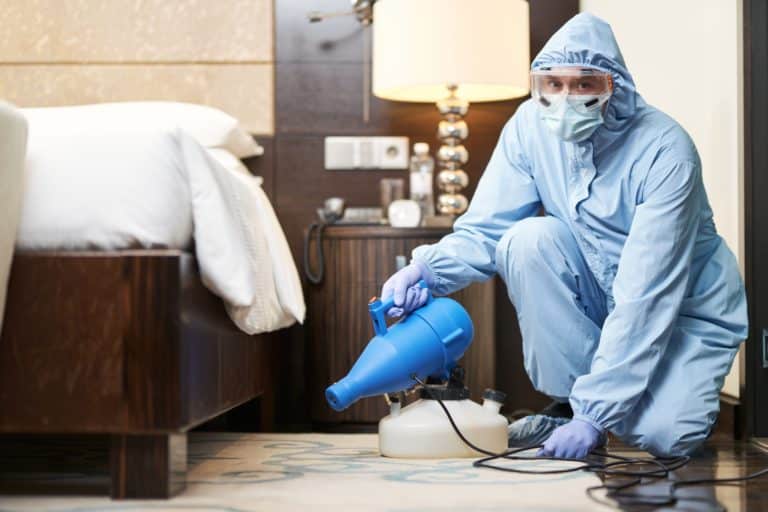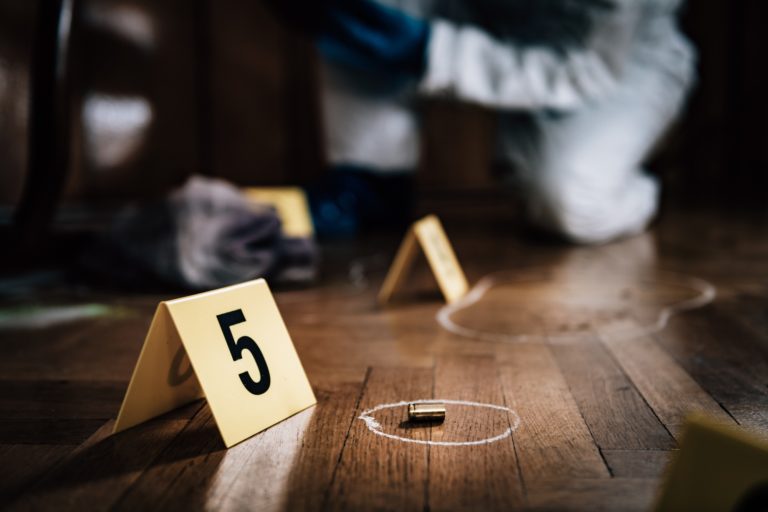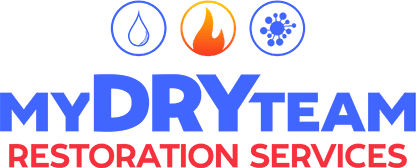BIOHAZARD Cleanup

Certified Cleanup for Homes and Businesses
Handling biohazardous materials requires specialized training, industry-approved safety protocols, and professional sanitation methods. These materials present serious health hazards, as they may contain infectious agents, harmful bacteria, and toxic substances. Whether resulting from trauma, unattended deaths, sewage backups, or hazardous waste spills, proper decontamination is necessary to restore safe conditions.
At My Dry Team Restoration, we provide expert biohazard cleanup using EPA-approved disinfectants, protective equipment, and compliant disposal techniques. Our IICRC-certified team follows OSHA safety standards to deliver thorough and discreet remediation for residential, commercial, and industrial properties.
What Qualifies as a Biohazard?
Common Biohazard Cleanup Situations/Common Biohazard Scenarios
- Trauma & Crime Scene Cleanup
- Unattended Death Cleanup
- Hoarding & Gross Filth Cleanup
- Sewage Backup Cleanup
- Rodent & Animal Waste Cleanup
- Industrial & Chemical Spill Cleanup


Trauma & Crime Scene Cleanup – Professional and Discreet Remediation
When a traumatic event occurs, proper cleaning and sanitization are essential to restore safety. Our trauma and crime scene cleanup services focus on thorough decontamination, eliminating bloodborne pathogens, biohazards, and hazardous materials. We work closely with law enforcement and insurance providers while maintaining strict confidentiality and professionalism to support those affected.
Unattended Death Cleanup – Restoring Safe Conditions with Care
An unattended death can create serious health risks due to decomposition, airborne contaminants, and biohazards. Our team follows strict industry protocols to clean, sanitize, and deodorize affected areas, removing all biological hazards. We provide prompt, respectful service to help families and property owners reestablish a safe and habitable environment.
Hoarding & Severe Contamination Cleanup – Safe and Respectful Remediation
Excessive clutter and extreme filth conditions pose health risks, cause structural damage, and create unsafe living environments. Our hoarding cleanup services address debris removal, sanitation concerns, and biohazards with a careful and discreet approach. We work to restore properties to livable conditions while maintaining sensitivity to those involved.
Sewage Backup Cleanup – Fast Response to Hazardous Contamination
Sewage backups introduce harmful bacteria, viruses, and toxic substances into a property, leading to potential health concerns. Our specialized cleanup services remove hazardous waste, sanitize surfaces, eliminate odors, and control moisture to prevent mold growth. We follow all health regulations to restore affected areas to a safe and functional state.
Rodent & Animal Waste Cleanup – Removing Health Risks for a Clean Environment
Accumulated rodent and animal waste can spread harmful pathogens, leading to respiratory issues, disease transmission, and structural damage. Our team safely removes waste, disinfects contaminated areas, and implements preventative measures to reduce the risk of future infestations. Our thorough cleanup process promotes a healthier indoor space.
Rodent & Animal Waste Cleanup – Removing Health Risks for a Clean Environment
Chemical spills in industrial and commercial settings require prompt containment and expert cleanup to prevent environmental and health hazards. Our trained professionals manage hazardous materials using approved decontamination techniques to neutralize toxins and restore workplace safety. We strictly follow OSHA and EPA regulations to maintain compliance and long-term protection.
Hoarding & Severe Contamination Cleanup – Safe and Respectful Remediation
Excessive clutter and extreme filth conditions pose health risks, cause structural damage, and create unsafe living environments. Our hoarding cleanup services address debris removal, sanitation concerns, and biohazards with a careful and discreet approach. We work to restore properties to livable conditions while maintaining sensitivity to those involved.
Sewage Backup Cleanup – Fast Response to Hazardous Contamination
Sewage backups introduce harmful bacteria, viruses, and toxic substances into a property, leading to potential health concerns. Our specialized cleanup services remove hazardous waste, sanitize surfaces, eliminate odors, and control moisture to prevent mold growth. We follow all health regulations to restore affected areas to a safe and functional state.
Our Certified Biohazard Cleanup Process
Biohazard cleanup involves a detailed process that follows strict safety protocols and regulatory requirements to protect public health and the environment. In Michigan, biohazard remediation must meet the standards set by agencies such as the Occupational Safety and Health Administration (OSHA), the Environmental Protection Agency (EPA), the Michigan Department of Environment, Great Lakes and Energy (EGLE), and local health departments. Below is an outline of the procedures involved in biohazard cleanup while adhering to all applicable regulations.
Step 1
ssessment & Risk Evaluation
Before cleanup, professionals assess the area to identify the type and extent of biohazard contamination, risks to occupants, and regulatory requirements. A remediation plan is then developed following OSHA’s Bloodborne Pathogens Standard and EPA hazardous waste disposal regulations.
Step 2
Containment & Safety Protocols
To prevent cross-contamination, the area is sealed with barriers and negative air systems. Cleanup crews wear PPE, including biohazard suits and respirators, following OSHA and HAZWOPER standards.
Step 3
Removal & Disposal of Biohazardous Materials
All biohazardous waste, including blood and contaminated materials, is disposed of following EPA and Michigan EGLE guidelines. These items are placed in labeled, leak-proof containers for transport to licensed disposal facilities. Contaminated porous materials like carpeting or drywall are disposed of according to Michigan’s medical waste regulations.
Step 4
Deep Cleaning, Sanitization, & Decontamination
The area is deep cleaned with hospital-grade disinfectants and EPA-approved agents to eliminate bacteria and viruses. Techniques like fogging, ozone treatment, and ATP testing ensure thorough sanitation, following CDC and OSHA guidelines.
Step 5
Verification, Restoration & Compliance Documentation
After decontamination, professionals conduct final tests, including air quality monitoring, surface testing, and moisture detection, to ensure all biohazards are removed. A Certificate of Decontamination may be issued, documenting all procedures for legal and insurance purposes.

Why Regulatory Compliance Matters
Michigan requires biohazard cleanup companies to follow strict legal and environmental regulations to protect public safety and prevent improper disposal of hazardous waste. Working with certified biohazard remediation professionals ensures that all cleaning processes meet OSHA, EPA, and state health standards, reducing liability risks and ensuring full compliance with Michigan laws. Would you like me to refine or expand any section based on specific cleanup scenarios?
Frequently Asked Questions (FAQs)
Why is professional cleanup necessary after a crime or trauma scene?
Crime and trauma scenes often contain blood, bodily fluids, and other biohazardous materials that may carry infectious diseases. Professional cleanup teams follow strict decontamination protocols, remove odors, and handle biohazard disposal in compliance with Michigan health and safety regulations.
Can all traces of blood and bodily fluids be removed?
Yes. We use hospital-grade disinfectants, HEPA filtration, and ATP testing to eliminate biological contaminants. The goal is to restore the affected space to a safe and habitable condition.
